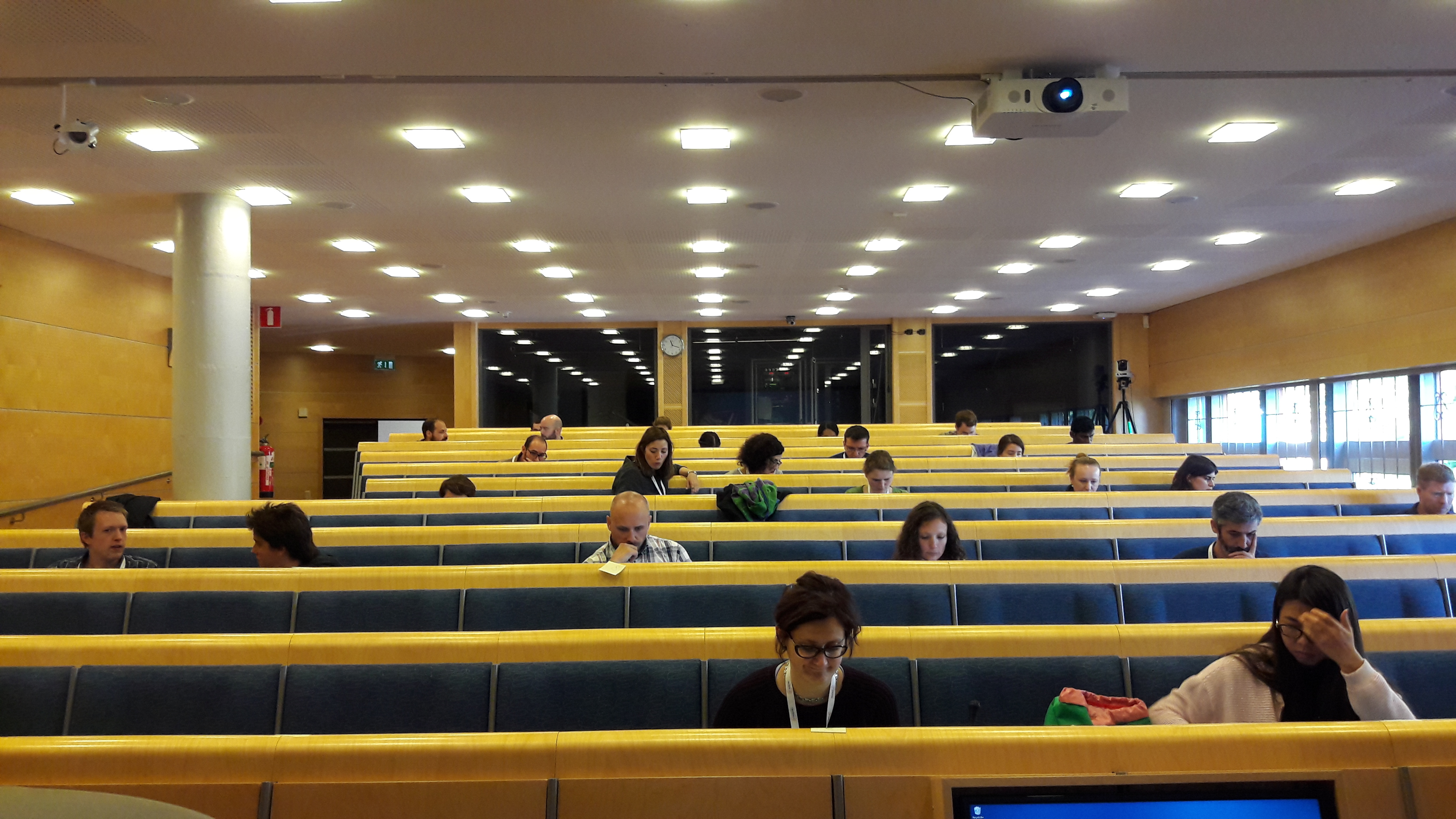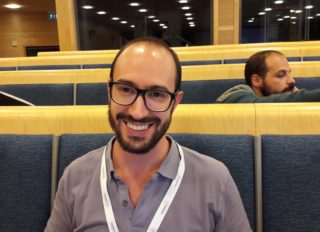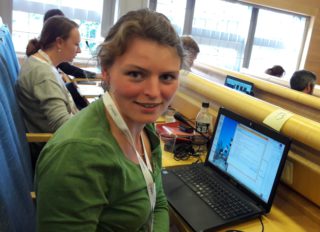By Gabriel Martins & Fabrice Cordelies (WG2)
After the success of the first round of training schools, with one for “Facility Staff” in Barcelona – Spain (Sept. 2016), one for Early Career Investigators (ECI) and one for Bioimage Analysts, both in Oeiras – Portugal (Feb. 2017), NEUBIAS debuted “season 2” with two news schools, one for ECIs and one for “Staff”, both hosted by Dr. Julia Fernandez-Rodriguez at the Centre for Cellular Imaging, Sahlgrenska Academy (University of Gothenburg) in Gothenburg – Sweden (September 11-14). The trainees selected for these two schools came from 18 different countries (Europe, Israel and US; seven trainees originating from COST “Inclusiveness Target Countries” were awarded travel grants), and they were assisted by a team of 23 trainers from 11 different countries.
The 25 trainees of the ECI school (TS4) were PhD students or Post-docs with a critical need for image analysis in their own research and availability to bring data (and laptops) to the school; no a-priori knowledge on image analysis was required. Applicants had to submit in a letter of motivation their level of proficiency and interests, and a mini-project with goals for the training schools (eg. a specific image analysis tool or workflow that they were interested in getting help from expert trainers) – this helped the organizers select the topics to meet the trainees expectations. The programme for the ECI school was prepared in collaboration with Nuno P. Martins (a former NEUBIAS trainee!) and Carolina Wählby, and included a first day dedicated to “using ImageJ for scientific illustration”, which introduced the basics of image processing and ended with an inspiring lecture on the ”Natural History of Fake Data” by Kota Miura. On the second day trainees learned how to “use ImageJ for Image analysis and building of workflows”, including visualization of 2D and 3D images and time-lapse sequences, and how to record and reuse commands to assemble basic workflows. On the 3rd day we delved into the “building of image processing pipelines with cellProfiler”, including a brief introduction to “machine learning with CellProfiler Analyst” by Beth Cimini, and in the 4th day, trainees were challenged to “choose a toolbox, work on own data and present results”. Although not initially planned, the trainees showed interest in learning also the basics of KNIME, which Anna Klemm (a former trainee of TS1, now recruited to train in TS4!) provided impromptu.
The school for “staff” (TS5) was co-organized by Jan Eglinger and Joakim Lindblad (with contributions by Giovanni Cardone, a former trainee from TS3!) and had a strong emphasis on scripting/automation of processes with ImageJ and MatLab. For this school we selected 25 applicants whose daily activities are mainly to train and support other researchers in imaging facilities. During the first two days trainees learned mostly scripting in ImageJ with sessions also on machine learning and advanced segmentation lead by Ignacio Arganda-Carreras, advanced scripting with Groovy to script tracking and track analysis with TrackMate lead by Jan Eglinger and Stefan Helfrich (a former TS3 trainee!). There was also a full day dedicated to Matlab including sessions on image processing and visualization of 2D and 3D datasets and discussion of more advanced analysis workflows. In the last day, trainees learned KNIME and tried to apply the learned techniques to dataset they brought to the school.
The programme of both schools was complemented by three public seminars on “Light-sheet Image Reconstruction and Application to Whole Organism Transcription Imaging“ by Stephan Preibisch, on “Deep learning in life science and microscopy” by Carolina Wählby”, and on “Single-cell analysis using machine learning and image analysis methods” by Peter Horvath.
Such a rich programme meant that the schools were well paced, but there were also plenty of moments for participants to interact and share experiences, including generous meals and coffee breaks and a fantastic gala dinner on a boat tour, a special treat for all participants prepared by the local organizers.
NEUBIAS WG2 thanks all the participants, especially the trainers and local-organizers for their excellent work and support, which helped make this edition another great success. We are all looking forward to the next schools (TS6 and TS7) which are scheduled to take place in Szeged – Hungary in January of 2018. These will include a new school for ECIs, this time targeting researchers and imaging facility staff already experienced with image analysis but looking for a more solid understanding of bioimage processing and analysis techniques, and a new school for Analysts which will be focused on the analysis of advanced workflows and algorithms of components. Stay tuned for the details of the programme for these schools through the NEUBIAS website.
Trainee testimonials (selected):
Joanna Pylvänäinen (TS5): “I participated in the 2nd Training School for Facility Staff. I didn’t have so much programming experience before attending this course, and learning four different image analysis methods during the four intense days drove me from excitement to frustration, and to everything in between. But finally I learned a lot about image analysis and most importantly, that I should not be afraid to ask for help. Now, one month after the course I have finished my first proper macro for a research group, and I could not be more proud of myself! I still have a lot to learn, but I’m into a very good start now, thanks to the great NEUBIAS trainers and the network. This course is totally worth attending!”
Fabio Socciarelli (TS4): “I had a great experience with the NEUBIAS training school! Both theoretical background and practical sessions were useful and well organized, after this course I could apply what I had learned soon to my work. Being part of the NEUBIAS community is a great advantage in terms of knowledge sharing and skills development in image processing and analysis.”
Hanna Grobe (TS4): “For me the TS4 in Gothenburg was a great success. Not only did I learn a lot of new and useful tools that I can now apply in my everyday work but it also reminded me of the basics and what the foundation of image analysis really is. A big compliment goes out to the motivated and enthusiastic trainers throughout the week. They made it easy to follow the courses and helped whenever it was needed. All in all it was an amazing experience and I’m looking forward to meeting everyone again at future events.’
Sebastien Herbert (TS5): “As a young staff scientist the NEUBIAS TS5 training was a formidable experience. I had a lot of fun experimenting loads of different approaches to practical technical questions and begun to apply them before even coming back to the lab. The informal atmosphere and the high number of trainees also made it a great opportunity to meet this very welcoming community and benefit from their experience. I am looking forward the next meeting!”






